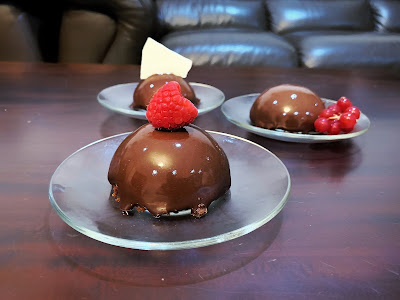Pulau Ubin isn't one of those places in Singapore where Singaporeans commonly go to. It's a small island located off the east coast, and transportation into the island can be a little spotty. And like all outdoor activities in tropical climates, the weather can be challenging. I love a good trek or two in cooler weathers when I’m overseas, but here, where people sweat from the heat even while indoors, it takes a rare occasion to pry me away from the comfort of air-conditioning.
So, when WWF (World Wide Fund for Nature) held a campaign to clean up the mangroves in Pulau Ubin one Sunday, no one is as surprised as I am to find myself there. We went much earlier than the appointed time, so we can watch the sun rise over the rest of Singapore (or at least we attempted to! - We couldn't find a proper vantage point). Ultimately, we had a more satisfying time at breakfast over in the nearby Changi Village Hawker Centre.
The boats ferrying passengers to-and-fro at the ferry terminal only leaves when there is a dozen passengers, so smaller groups may have to cool their heels a little at the ferry terminal. Our sizable numbers meant that we boarded quite easily and were soon on our way.
As we made our way from the harbour into the island, it feels like we had been transported out of Singapore. The quaint structures seem right out of a set from a period drama, or from a bygone era of history. Despite being a sleepy town, the great outdoors beckons to travelers. There's kayaking, mountain-biking, and trekking around the wetlands or quarries. Adventurous 'uns can even go camping. WWF had liaised with a local adventure company for our expedition into the mangroves. A quick rundown of the basics of kayaking after, and we were off!
Our fleet of budding kayakists set off together, shepherded by capable hands from the company. We stopped every so often, as our guides, intimate with the area, named the wildlife and shrub, and explained their role in the mangroves. The waters were a deep murky green, which progressively lightened as we proceeded into the deeper areas of the mangroves. We rowed past a section of the coast, where the now-defunct resort of Pulau Ubin stood.
It was a beautiful day for a row, and it was a side of Singapore that I hadn't appreciated before. Items we picked out of the mangroves ranges from small water bottles to big barrels, which were likely discarded in the surroundings waters and swept into the mangroves by the currents. Not all of the larger items could fit into the kayak, but we fished out as much as we could.
A few hours into the expedition, we headed back to shore, and had a leisurely lunch at Season Live Seafood. There was prawns, steamed fish and fried yam. It was sumptuous! There was a smattering of rain as we ate, but luckily, the winds begin to shift towards the end of our meal, and a bright spot of clear sky opened, and just in time to catch the bumboat back to the mainland.
 |
| Fall colours in Pulau Ubin, or did someone forgot to water this plant? |
***********
Pulau Ubin is a beautiful island, and slightly rough around the edges. The efforts of WWF in preserving the environment here is admirable, and especially considering the lengths that they had gone through to make the lives of volunteers a little easier, from organising shutter transportation to the Changi, to buying lunch for the volunteers. I appreciate how a tour group (Asian Detour) was charted by WWF to bring us around the mangroves. We went home afterwards, now a little wiser about the mangroves of Pulau Ubin.
Despite my copious amounts of sunblock, I had a good sunburn situation going on and consoled myself by lapping up a well-deserved ice cream at Birds of Paradise. It wasn't as close to the ferry terminal as I had envisioned, but it's good enough to warrant a detour!


























